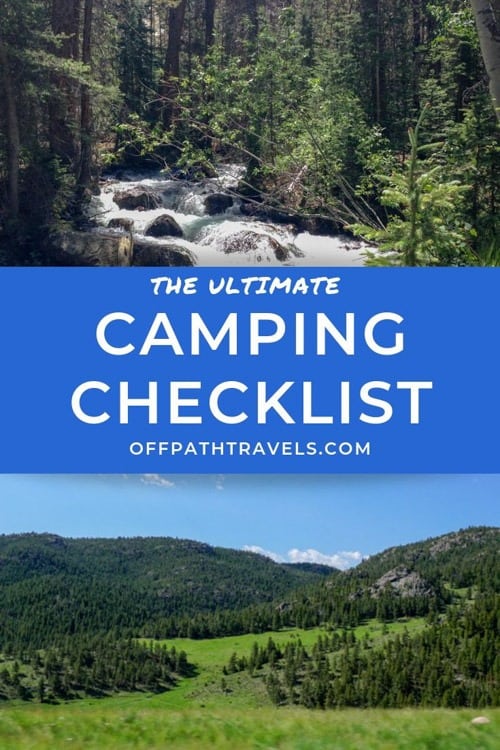Who doesn’t love escaping it all to spend a night under the stars? Whether you’re backpacking far into the bush or just stopping by your local campground, the gear can make a world of difference. Here’s a basic rundown of our favorites in our essential camping checklist.
If you want to skip the tips and recommendations, no worries! The Off Path Travels Essential Camping Checklist is at the bottom of this post. We’ve even included a downloadable/printable PDF version for no cost!
Leave No Trace
One of the most important things for any camper is understanding of the Leave No Trace principles: plan ahead and prepare; travel and camp on durable surfaces; dispose of waste properly; leave what you find; minimize campfire impacts; respect wildlife; and be considerate of other visitors.
If you’re not familiar, take a moment to commit these to memory before your next adventure. Let’s do what we can to keep this world beautiful.

Tents and Shelters: The Most Important Part of Any Camping Checklist
Unless you have a recreational vehicle or van with a bed, you’re going to need somewhere to sleep. You can go with a simple tent to throw on the ground, a roof top tent (the latest craze), or perhaps look into making a platform inside of your truck or large SUV.
Tents come in all sorts of sizes and shapes, so don’t be afraid to look around for what suits you best. The vast majority are not meant for use during cold winter temperatures, so if that’s your goal, then make sure to find a 4-season tent.
For basic car camping, there’s nothing wrong with using budget-friendly models to start off with. Their biggest downfall is that they probably won’t last very long and they might not fare so well against poor weather. Coleman makes some great entry-level tents.
Backpacking is a different story. You’ll need a much lighter tent which is dependable and can withstand difficult conditions well. Otherwise you might end up deep in the wilderness, soaking wet, huddling under a broken tent.
Some people like to save weight by using a bivy when they backpack. These are very small enclosures which basically wrap around the sleeping bag and has no other interior space. Incredibly lightweight, but doesn’t provide a lot of shelter. The Outdoor Research Helium Bivy is a great example, and if you haven’t used any Outdoor Research gear before, you’ll be in for a nice surprise. Their stuff is incredible.
But if you want a backpacking tent that has a bit more headroom and a bit of storage space (very handy in poor weather), then the MSR Hubba Hubba NX is our top choice (and what we use personally). Each side has it’s own door and vestibule; it uses a really simple unified hub system for the poles; and it only weighs 3.5 pounds! If you want to save a few bucks, the REI Half Dome is a very similar tent.
When you’re using a tent (backpacking or not), many people like to protect the base of the tent by placing a footprint underneath it. A footprint can be a tarp, but it’s best to have the footprint be the same size as the tent, otherwise it may collect and funnel unwanted water underneath the tent. Most high-end tents have footprints made to use with them, like this footprint for the MSR Hubba Hubba NX.
There’s a growing trend in the camping and overlanding world toward roof top tents (RTTs). They are popular due to their nearly instant setup and having a nice flat sleeping area high off the ground. The downfalls are that you’ll always need to find a flat place to park, they are not cheap, and they can make vehicles a bit top-heavy. The Smittybilt Overlander Tent is a pretty solid value RTT.
If you want to be a bit more secure and you have a fairly large vehicle, then you might be able to sleep inside of it by folding the seats down or building a simple platform in your large SUV or truck bed. Many people construct platforms out of nothing more than a bit of wood, ourselves included. In fact, that’s what we usually sleep in when we’re camping or overlanding.
We built our sleeping platform inside of a Chevy Tahoe in order to explore as much as possible. It has tons of storage underneath, leaves the roof open for our roof bin, and allows us to sleep inside of secure space. Just don’t forget to include some ventilation.
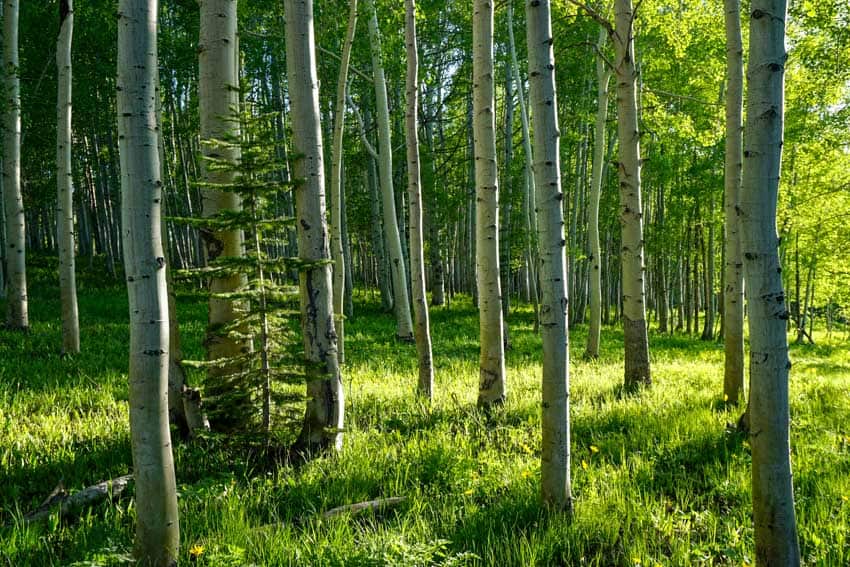
Sleeping Bags and Pads
Once you have a place to sleep, you need something to sleep in to keep you warm. Even on some of the warmer nights camping, you’d be surprised how cold it can get when you’re sleeping outside. And don’t forget about extreme temperature fluctuations which occur regularly in high-altitude locations, as well as deserts.
There are two pieces of essential camping gear to stay warm inside your tent: a sleeping bag and a sleeping pad. You have to have both of these on your essential camping checklist.Sleeping bags are usually rated based on the temperature they can withstand while keeping the occupant warm. If you’re car camping and size/weight aren’t a huge concern, it’s wise to get a bag that’s rated for temperatures lower than you anticipate.
No one likes to be cold. The Teton Sports Tracker is a good value option and will keep you warm in almost any conditions. When backpacking, you’re going to want the lightest sleeping bag possible. There are plenty of traditional options out there – such as the Sea to Summit Traveller – but there’s a new style of sleeping bag which we prefer. They’re called quilts.
By using a quilt, you can save space and weight. Rather than wrapping all the way around you, it simply connects to your sleeping pad on your sides and does not have material underneath. We love our a two-person Therm-a-Rest Vela and the Therm-a-Rest Coupler, an essential add-on to our camping checklist PDF.
Sleeping bag liners are a great addition to your setup as well. They can boost the insulation of your sleeping bag. Use them in the coldest nights and remove them when it’s warm.
Even with a warm sleeping bag, you need to stay insulated from the ground. That’s where sleeping pads come in. The best sleeping pads are rated based on the level of insulation they provide from the ground, called an R-value.
Depending on your temperatures, a simple foam sleeping pad with do the trick. Some people prefer to use cots.
For backpacking, many people prefer inflatable sleeping pads. We use Therm-a-Rest Neo Air and Klymit Static V. Going with foam pads is perfectly acceptable and will keep you warm.

Cookware: A Camping Checklist Personal List
The essential camping gear list can get a lot longer with cookware, and everyone has their own preference, but nothing beats an open fire.
Check out our detailed post with everything you need for the Ultimate Camp Kitchen.
We love cooking over a camping grill grate or dutch oven placed on rocks around red-hot coals.
Camping stoves are also a godsend, especially in the morning or to make boiling water. Our favorite brand for camping stoves is Camp Chef. Their Rainer model is also popular since it has a stove and grill in one unit.
Portable grills are a nice addition too. You can go with the Coleman RoadTrip which has a built in stand and plenty of power to cook large meals. Char-broil has an inexpensive one that lasted years for me. Perfect for tailgating too.
And forget about the small green propane tanks! Get an adapter hose and either use the big tank you have in your grill or buy a 1-gallon /5-pound tank. It has a large capacity and is refillable. A great addition to any camping checklist printable version!
For a full breakdown of the 5-pound propane tank’s, check out our article on why you need a 5-pound propane tank for camping here.
.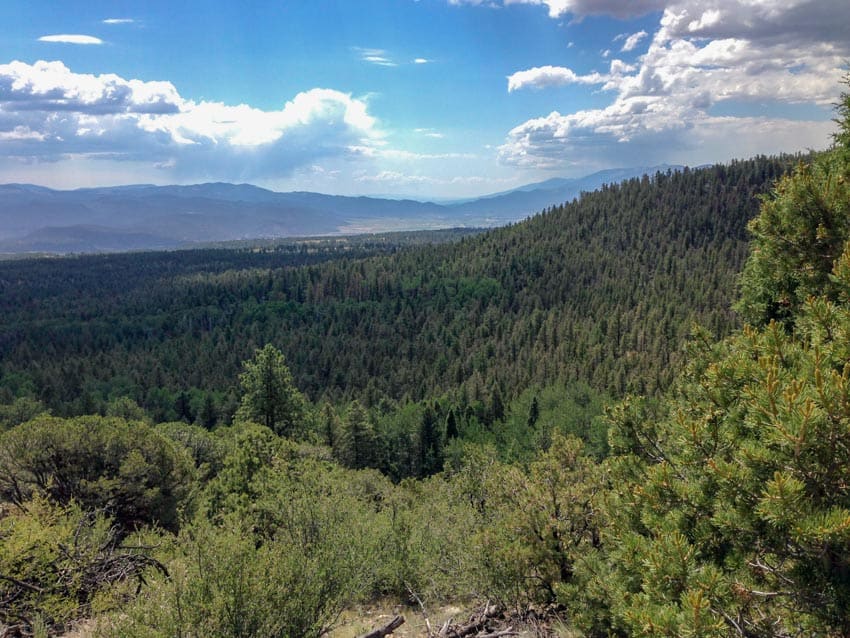
Like nearly everything else with backpacking, the stoves are much smaller and lighter. A lot of people are choosing to go with small kits that have a burner, pot, and room for a gas canister all in one. Nice and compact.
The Jetboil Flash and MSR’s WindBurner are two great options if you’d like a simple kit like this. We do not prefer these though because they only use single-use canisters which are specially made. If you aren’t near an outdoor store that stocks them, you’re SOL.
Instead, we love the tried-and-tested MSR WhisperLite, which can burn basically any fuel: white gas (often used in lanterns), single-use gas canisters, and ever something as basic as gasoline (although you only want to do that when nothing else is available. It’s a bit more maintenance, but this is a stove that has been used for decades by some of the most advanced outdoorsman and is an industry standard. An easy addition to any camping checklist PDF.
As far as coolers go, don’t get too worked up about them. While did splurge on a Yeti cooler, and it is incredible, but we camped for decades before having one. The roto-molded coolers are superior, but they’re not a refrigerator. Pro-tip: get your cooler and the things you’re putting in there cold before leaving. That’s not on the checklist, but it should be on your preparation list.
The world of portable refrigerators that can run off of a solar setup too. The Dometic Fridge Freezer is an awesome choice, but not too budget-friendly. Be careful if you look at the cheaper options; some of them can only make the temperature 10-20 degrees less than the ambient air temperature.
Did you just get caught up on the solar setup? Well, if you don’t have solar for your camping setup yet, make sure to read our article on camping solar panels to figure out what fits your needs the best.
And, of course, all of the little kitchen things need to be thrown in too: plates, silverware, napkins, cups, mugs, grilling utensils, pot, pot holder, and can opener. In this category, I wouldn’t want to go without my favorite: Snow Peak titanium mugs for backpacking.
Water / Clothing / Chairs / Table
Reusable jugs like these are the way to go for water. Single-use ones are lame, a waste of money, and bad for the environment. You’ll save money in as little as two outings.
If you’re tight on space, they also make collapsible ones. Making sure to bring enough for eating, drinking, washing hands, cleaning, and putting out fires. Some people recommend 2 gallons per person, per day. But it depends on your personal usage. Always bring more than enough!
For backpacking, Sawyer makes some of the best bang-for-your-buck water filters on the market. And they’re tiny!
If you’re going to areas which might have fairly significant water pollution or poor quality, then you should consider investing in a purification system, such as the GRAYL Geopress. Although a bit more expensive, it does a much more thorough job at providing you with clean water.
Some people hate camping because they can’t shower. Fear no more. It’s cheap and easy to build your own outside shower! Ours is made for 4” diameter PVC pipe and can be made in 30 minutes or less! Great addition to the camping gear. Check out CombiLife’s DIY write-up.
As far as clothing goes, you’ll have some people tell you that you can NEVER use cotton anything while camping. Well,I’ll let you in on a secret: people have used their normal, cotton clothes for camping for decades. If you’re camping near the car in fairly comfortable conditions, don’t overthink it. Just understand that your clothes will probably be the dirtiest and smelliest they’ve even been, so leave the nice stuff at home.
Having said that, it absolutely is best to use as little cotton as possible because it gets wet easily and takes a long time to dry. Especially when backpacking when your life depends on it. All of our underwear (ExOfficio), socks (Darn Tough), and base layers are cotton-free.
Don’t forget to throw in things to keep you warm and dry. Those low 60 degree nights seem fine when you’re on your couch, but they can creep into your bones in the wilderness. Hats, gloves, rain jackets, and boots are all a good idea for your camping checklist PDF. Being cold and wet is a recipe for disaster. Don’t leave these important off of your camping checklist printable version.
For seating, we use Coleman Quad Chair. Nothing fancy, but it does the trick and even has a built-in cooler! Keep a few cans nearby so you don’t have to run to the cooler as often (it also keeps the cooler cold by not opening it as much).
As far as camp tables go, you might not need to worry about it if you’re going to campground. But if you’re dispersed camping or want a bit more counter space, the ALPS Mountaineering Table is incredible. It’s lightweight, sturdy, and compact for storage. Highly recommended. But don’t get too caught up in this; less portable tables and even logs/rocks can suffice as well.
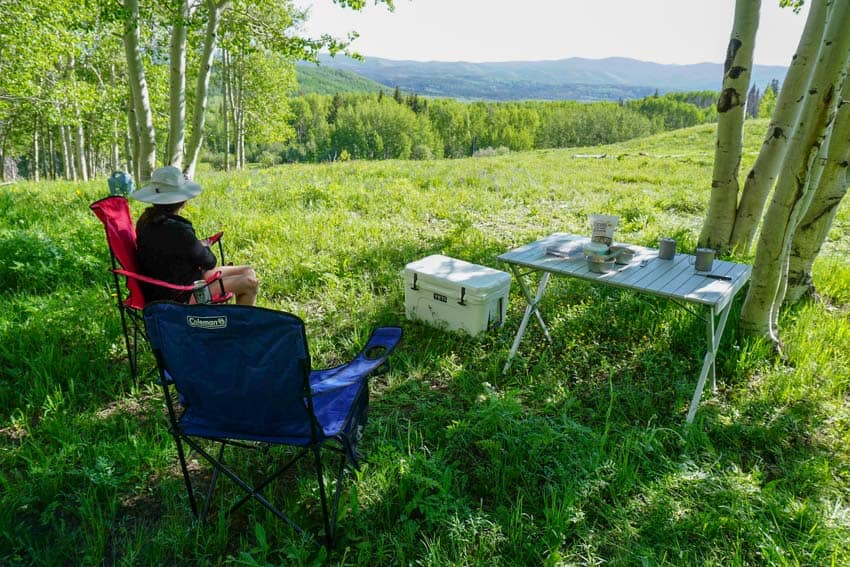
Bathroom and Personal Care
Sometimes there are facilities in the areas we stop at, but most often, there are not. To take care of the environment the best, the Cleanwaste Go Anywhere bags are the thing to reach for. But if you don’t want to pack out your poo poo, digging a cat hole is still common. Just don’t do this in extremely busy areas.
We bring a small trowel made by The Tent Lab with us when backpacking. If we’re camping with the car, we bring a mini shovel with, or even your garden shovel from home if nothing else.
Bring toilet paper and wipes, which should be packed up and taken with your trash. Black ziplock bags help keep the “eww” factor to a minimum. Yes, it is not pleasant to deal with it, but these are essential items on our camping checklist PDF. If you really can’t deal with that, PLEASE BURY IT DEEP! Can’t tell you how often we see disgusting toilet paper floating around beautiful campsites.
Don’t forget some hand sanitizer and soap; getting sick in the backcountry is not fun. Dr. Bronner’s soap is great for the outdoors.
This is one of the most important items on the essential camping gear list. Take where you go to the bathroom seriously. Don’t go near water, or trails, or designated campgrounds. Dig it deep and cover it well. No one wants to see/smell/feel what you’ve left behind. Don’t be “that guy” (or gal).
You’ll want to bring sunscreen, bug repellent, deodorant, toothbrush, toothpaste, and whatever other hygiene products you need to stay comfortable. Stay away from strongly-scented items if at all possible to mitigate attracting wildlife.

Miscellaneous Camping Checklist Items
Don’t go away without a first aid kit, telling someone where you’ll be and when you’ll be back, and a good map. Gaia GPS is a widely-trusted mapping brand and digital favorite, but I also love a paper map, especially one that holds up and has all the stuff you need for overlanding. National Geographic makes some seriously incredibly physical maps with roads, trails, and attractions.
Said it once, but I’m going to mention it again: Learn LEAVE NO TRACE principles before heading out.
You’ll also want to consider bringing your own firewood (but not from too far away), a handsaw, an axe/hatchet, and possibly a chainsaw. Fire-starters (logs, bricks, wicks), matches, and a lighter help. Check the local fire restrictions (county, city, ranger district, and forest/park regulations). Only use wood that is on the ground; don’t cut down a tree or even low hanging branches.
I prefer to use a simple bow saw to cut logs. It’s cheap, safe, and the blades can be found almost anywhere. Combine that with a hatchet to split the wood, and you’ve got all you need for a roaring fire. Some people love bringing chainsaws with, but they are dangerous, loud, and pretty unnecessary unless you are having a giant bonfire. But let’s be honest, who wants to burn that amount of wood on a regular basis. A bit wasteful, and if you join the hardcore camping world, you’ll soon learn that it’s actually quite lovely to camp with a small fire – or no fire at all!

Trash bags, stuff sacks, dry bags, and bear devices many need to come along too.
Solar lanterns are our new favorite toy. MPOWERD’s are unreal. They even make one that has a battery and USB connection for charging small devices. Propane lanterns can really light up space (Coleman NorthStar is amazing, but get the case! They’re fragile).
Headlamps are great for keeping your hands free. Have you ever tried to do the dishes while holding a flashlight? Not easy. Black Diamond makes some excellent headlamp choices and are what we’ve used for years.
Don’t forget to bring some games, frisbees, cards, books, and whatever else we want to keep us busy and have fun!
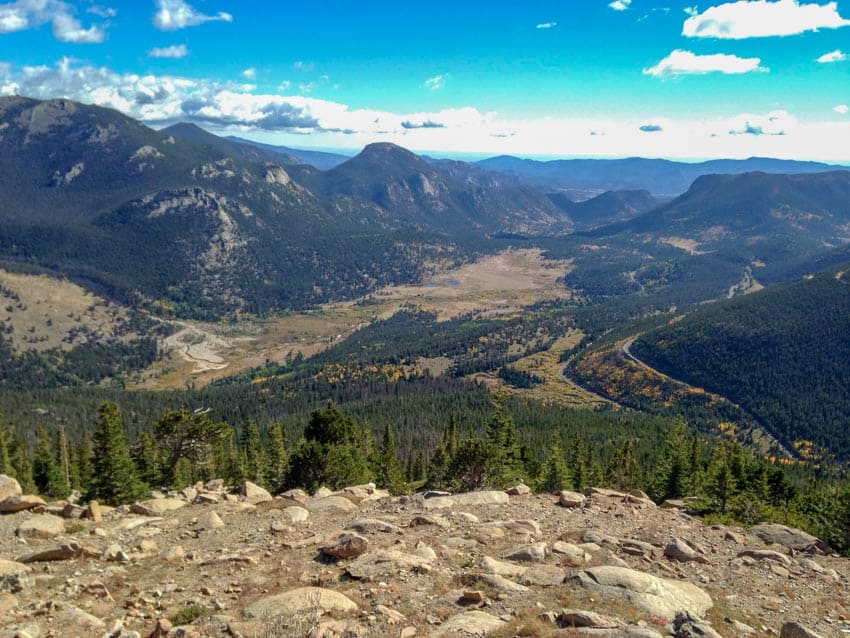
Summary of The Ultimate Camping Checklist
And that does it for the essential camping checklist. If you have all of that, you have the essential camping gear. Stock up on food, drinks, gas, ice, and firewood, then hit the road!
Here is the Off Path Travels Ultimate Camping Checklist:
- Tent
- Sleeping Bag
- Sleeping Pad
- Tarp / Shelter
- Chair / Hammock
- Table
- Cooking Supplies:
- Grill / Stove / Dutch Oven / Pot
- Propane / Fuel
- Cooler
- Plates
- Silverware
- Knives
- Napkins
- Cups and Mugs
- Spatula / Ladle / Grilling Fork / Skewer
- Pot and Pot Holder
- Can, Bottle, and Wine Openers
- Portable Sink / Sponge
- Water Jugs & Water Filter
- Food:
- Breakfast
- Lunch
- Dinner
- Snacks
- Drinks
- Water
- Ice
- Clothes:
- Underwear
- Socks
- Base Layer
- Pants / Shorts
- T-shirts / Long-sleeved Shirts
- Hats and Gloves
- Rain Jacket / Warm Jacket
- Boots / Hiking Shoes
- Personal Care:
- Towel
- Waste Bags / Trowel
- Toilet Paper & Ziplock Bags
- Environmentally-Friendly Soap
- Hand Sanitizer
- Sunscreen
- Deodorant
- Toothbrush and Toothpaste
- Bug Repellent
- First Aid Kit
- Firewood
- Fire Starter, Matches, and Lighter
- Axe / Saw
- Trash Bags, Stuff Sacks, and Dry Bags
- Bear Bag or Container & Bear Spray
- Lantern
- Flashlight / Headlamp
- Map & Compass
- GPS Device / Phone
- Battery Pack
- Charging Cord
- Games
- Anything else you need!
Want the camping checklist in a printable format?! You’re in luck. Download the Off Path Travels – Essential Camping Checklist PDF right here, for free!
Think we’re missing something? Leave us a comment below to let us know what else we need to add to our essential camping checklist!
Like this post? Pin it!
